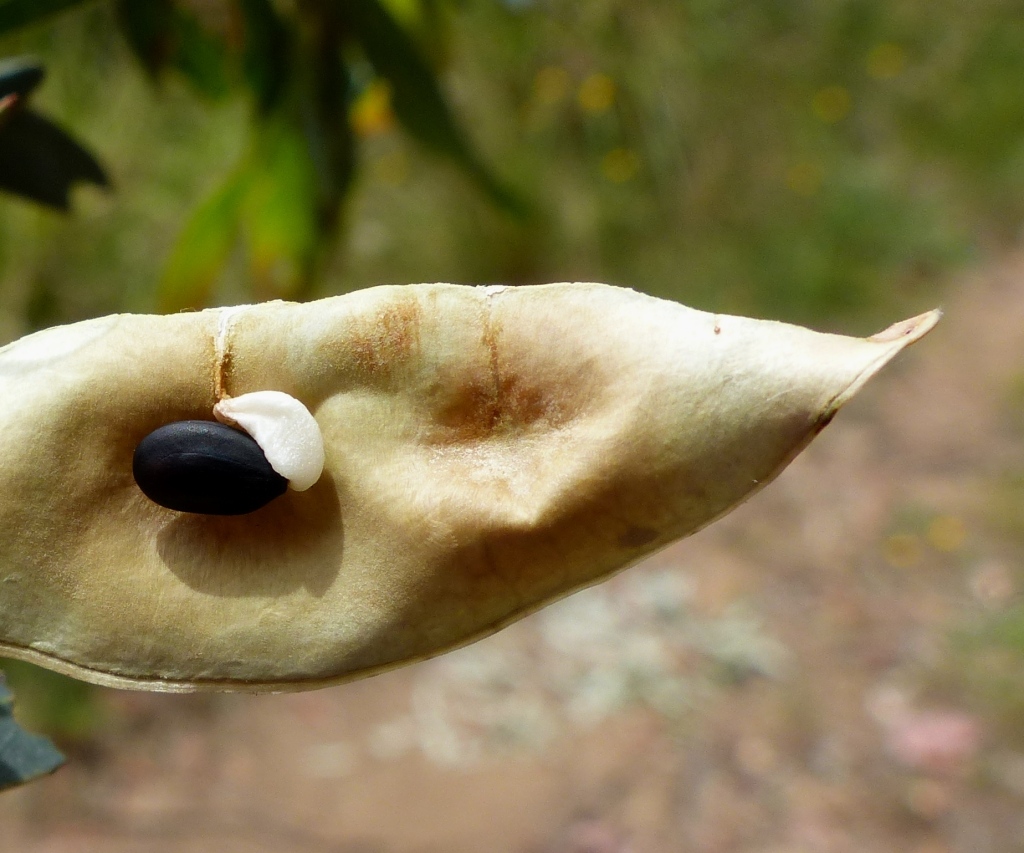Acacia kettlewelliae
Maiden Buffalo WattleBushy shrub or tree, usually 2–10 m high; branchlets angled at extremities, glabrous. Phyllodes on raised stem projections, narrowly elliptic to narrowly oblanceolate, usually 4–10 cm long, 3–10 mm wide, minutely mucronate, thin, green to glaucous, glabrous except for adaxial side of pulvinus which is usually sparsely hairy; midrib prominent, lateral veins obscure; gland submerged and swollen within the lamina, orifice at distal end of gland and usually downward-pointing, mostly 5–15 mm above pulvinus. Racemes prolific in upper axils, rachis usually 1–7 cm long, usually glabrous; peduncles 2–4 mm long, usually glabrous; heads globular, usually 8–11-flowered, bright light golden. Flowers 5-merous; sepals united; ovary usually glabrous. Pods 5–10 cm long, 8–14 mm wide, firmly chartaceous, dehiscing unilaterally, glabrous, sometimes pruinose; seeds usually longitudinal to oblique, oblong-elliptic to ovate, 4–5 mm long, somewhat dull, black, aril clavate. Flowers Sep.–Nov.
VRiv, CVU, NIS, EGU, HSF, HNF, MonT, VAlp. Also NSW. Occurs in the Great Dividing Range from the Southern Tablelands in New South Wales through to Mt Buffalo. Mostly in high-altitude montane forest, but also growing on lower slopes and near streams. Collections in MEL labelled 'Grampians Mountains' and 'Mt La Trobe [Wilsons Promontory]' are presumably in error or plantings.
The taxonomic status of A. oreophila Maiden & Blakeley and A. walteri Maiden & Blakeley require further investigation. Although Willis (1957, 1973) regarded them as conspecific with A. kettlewelliae, the types differ from A. kettlewelliae in their densely hairy ovaries and more numerous flowers per head. In addition, in A. oreophila the phyllode gland is pustulate and exserted with a minute central orifice, while in A. walteri there are 1-3 glands which, although somewhat similar to those of A. kettlewelliae, have a larger orifice not pointing downwards.
2 variants of A. kettlewelliae may be evident in the field. On drier woodland sites the species is a shrub c. 2 m high, with short, narrow (to c. 5 mm wide), slatey grey-green to glaucous phyllodes; this variant may resemble A. boormanii subsp. gibba. In wetter forests it can be a shrub or small tree to 10 m high, with long, broad (to 10 mm wide), olive-green to sage dark green phyllodes.
Hybrids with Acacia pravissima occur at Paradise Falls near Whitfield.
Entwisle, T.J.; Maslin, B.R.; Cowan, R.S.; Court, A.B. (1996). Mimosaceae. In: Walsh, N.G.; Entwisle, T.J., Flora of Victoria Vol. 3, Dicotyledons Winteraceae to Myrtaceae, pp. 585–658. Inkata Press, Melbourne.
 Spinning
SpinningWillis, J.H. (1973). A handbook to plants in Victoria. Melbourne University Press, Carlton.


